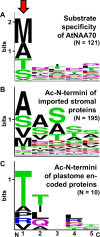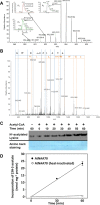Molecular identification and functional characterization of the first Nα-acetyltransferase in plastids by global acetylome profiling
- PMID: 25951519
- PMCID: PMC4692087
- DOI: 10.1002/pmic.201500025
Molecular identification and functional characterization of the first Nα-acetyltransferase in plastids by global acetylome profiling
Abstract
Protein N(α) -terminal acetylation represents one of the most abundant protein modifications of higher eukaryotes. In humans, six N(α) -acetyltransferases (Nats) are responsible for the acetylation of approximately 80% of the cytosolic proteins. N-terminal protein acetylation has not been evidenced in organelles of metazoans, but in higher plants is a widespread modification not only in the cytosol but also in the chloroplast. In this study, we identify and characterize the first organellar-localized Nat in eukaryotes. A primary sequence-based search in Arabidopsis thaliana revealed seven putatively plastid-localized Nats of which AT2G39000 (AtNAA70) showed the highest conservation of the acetyl-CoA binding pocket. The chloroplastic localization of AtNAA70 was demonstrated by transient expression of AtNAA70:YFP in Arabidopsis mesophyll protoplasts. Homology modeling uncovered a significant conservation of tertiary structural elements between human HsNAA50 and AtNAA70. The in vivo acetylation activity of AtNAA70 was demonstrated on a number of distinct protein N(α) -termini with a newly established global acetylome profiling test after expression of AtNAA70 in E. coli. AtNAA70 predominately acetylated proteins starting with M, A, S and T, providing an explanation for most protein N-termini acetylation events found in chloroplasts. Like HsNAA50, AtNAA70 displays N(ε) -acetyltransferase activity on three internal lysine residues. All MS data have been deposited in the ProteomeXchange with identifier PXD001947 (http://proteomecentral.proteomexchange.org/dataset/PXD001947).
Keywords: Arabidopsis thaliana; AtNAA70; Chloroplast; Nα-acetyltransferase; Plant proteomics.
© 2015 The Authors. PROTEOMICS Published by Wiley-VCH Verlag GmbH & Co. KGaA, Weinheim.
Figures





References
-
- Behnia R, Panic B, Whyte JR, Munro S. Targeting of the Arf-like GTPase Arl3p to the Golgi requires N-terminal acetylation and the membrane protein Sys1p. Nat. Cell. Biol. 2004;6:405–413. - PubMed
Publication types
MeSH terms
Substances
LinkOut - more resources
Full Text Sources
Other Literature Sources
Molecular Biology Databases

